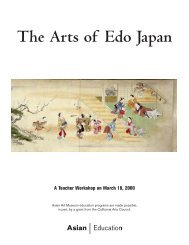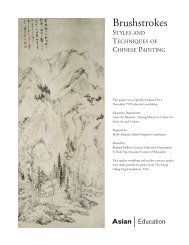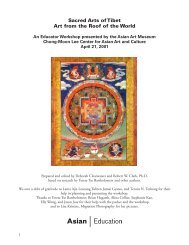China:The Glorious Tang And Song Dynasties - Asian Art Museum ...
China:The Glorious Tang And Song Dynasties - Asian Art Museum ...
China:The Glorious Tang And Song Dynasties - Asian Art Museum ...
Create successful ePaper yourself
Turn your PDF publications into a flip-book with our unique Google optimized e-Paper software.
the development of Daoism. This support included building Daoist temples and establishing<br />
schools to enroll students studying Daoist canons. Under the patronage of the emperors, Daoism<br />
flourished in the <strong>Tang</strong>. Nonetheless, Daoism had to compete with Buddhism for converts. Such<br />
competition is reflected in a passage written by Han Yu entitled “<strong>The</strong> Girl of Mt. Hua.” It relates<br />
how a female Daoist priest, in rivalry with Buddhists, used her charm and eloquence to attract an<br />
audience:<br />
In streets east, streets west, they expound the Buddhist canon, clanging bells, sounding<br />
conches, till the din invades the palace. <strong>The</strong> girl of Mount Hua, child of a Daoist<br />
home, longed to expel the foreign faith, win men back to the Immortals; she washed<br />
off her powder, wiped her face, put on cap and shawl. With white throat, crimson<br />
cheeks, long eyebrows of gray, she came at last to ascend the chair, unfolding the<br />
secrets of Truth.<br />
(Translated by Burton Watson, from the Columbia Book of Chinese Poetry)<br />
From this text, we learned that monks customarily traveled far and wide to preach their doctrines,<br />
causing unease among Daoists. In this instance, a female Daoist engaged herself among the<br />
field of proselytizers and won over the monks. However, generally speaking, during the <strong>Tang</strong><br />
dynasty Buddhism was more influential than Daoism.<br />
In the waning years of the <strong>Tang</strong>, Daoism experienced a setback. However, in the <strong>Song</strong>, Daoism<br />
recovered and reached the height of its popularity during the reign of Emperor Huizong<br />
(1100–1125). Emperor Huizong invited Daoist priests to his court to teach him Daoist alchemy.<br />
He appointed famous Daoist teachers to high positions in the government. He established Daoist<br />
temples across the empire. He also constantly performed Daoist rituals in his palace. <strong>The</strong> emperor<br />
went so far as to declare himself to be the personal protector of Daoism. To defeat Daoism's rivals,<br />
he at one point used his authority to ban Buddhism. <strong>The</strong> emperor’s zeal influenced his ministers,<br />
and many of the high officials at court likewise showed an interest in Daoism. <strong>The</strong> reign of Huizong<br />
was the heyday of Daoism in <strong>China</strong>. Daoism persists as an important religion in contemporary<br />
<strong>China</strong>.<br />
CHRISTIANITY<br />
Nestorianism was the first branch of Christianity brought to <strong>China</strong>. After breaking from the<br />
Western church during the Council of Ephesus in 431 over differences concerning the nature of the<br />
Holy Trinity, Nestorians took refuge in Persia and dispersed widely through Asia. <strong>The</strong> record of the<br />
781 Nestorian Monument (discovered in 1623, during the Ming dynasty) in the <strong>Tang</strong> capital has<br />
been translated as follows:<br />
“In 635, during the reign of Emperor Taizong [627–649], a Nestorian missionary A-lo-bun<br />
came to the capital of <strong>China</strong>, Chang’an. He was received by the prime minister Fang Xuanling. A-<br />
lo-bun stayed in the capital and translated Nestorian scriptures there. In 638, Emperor Taizong<br />
issued an edict concerning Nestorianism. In the edict, Taizong considered that the teachings of<br />
Nestorianism were helpful to human beings, and he permitted the Nestorians to teach their doc-<br />
11
















